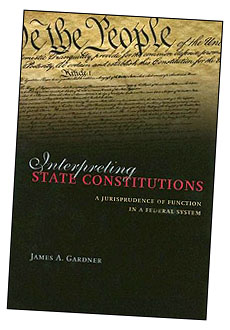Archives
States may become constitutional battlegrounds over civil liberties
By JOHN DELLA CONTRADA
Contributing Editor

GARDNER
Constitutional battles over civil liberties could intensify at the state level—continuing a more than two-decade-long trend—if the Supreme Court becomes more conservative under President Bush with the retirement of Sandra Day O'Connor, according to UB Law Professor James A. Gardner.
"The turning away of the U.S. Supreme Court from the expansion of civil liberties over the past 25 years has meant that people dissatisfied with the Supreme Court have looked to state constitutions to fill that gap," says Gardner, author of the new book "Interpreting State Constitutions: A Jurisprudence of Function in a Federal System" (2005, University of Chicago Press).

"The more governmental responsibility states have undertaken, the more important state constitutions have become."
State courts, Gardner points out, recently have rendered significant decisions that were contrary to federal rulings in cases involving search and seizure, freedom of speech and sodomy. Gay rights and abortion may be the next major issues addressed at the state constitutional level, depending on the actions of the Supreme Court in coming years, he says.
"The reason that these state constitutional decisions get attention is not just because they deal with important individual rights, but because every time a state court rules contrary to the Supreme Court, it's a slap in the face to the Supreme Court, it's a rebuke. It's saying, 'You don't really understand what our rights are and how we should protect them.'"
In his book, Gardner traces the emergence of federalism—the sharing of power between the states and the national government—and offers advice on how state judges and lawmakers should interpret their constitutions to protect civil liberties and promote national discourse on constitutional rights. Though historically this process has produced conflict between state and national governments, it has been essential to the protection and emergence of individual rights, Gardner argues.
"State and national governments, in my view, are bound together in a joint enterprise that partly consists of the protection of liberty," he explains. "Part of the function of state courts is to check and deter abuse of power by the national government.
"One way that state courts can perform that function is through interpretation of the state constitution—to either allow state officials to act in a certain way or to prohibit them from acting in a certain way—even if the Supreme Court has taken the other position."
The political turmoil that results from these debates can be confusing to the average citizen, who may not be aware that state constitutional law is independent of federal law and need not follow it or even acknowledge it, Gardner says. "People like certainty, and this process can be extremely complicated and unsettling. It's a harder process to live with because it means that issues are never really or absolutely settled."
Confusing matters even more are state and federal politicians who routinely tread on one another's domain, Gardner says. The Bush administration, with its focus on classic state issues like tort reform and education, has been more intrusive of state power than any administration since the Carter administration, he says.
"There's a school of thought that says people prefer the exercise of national power," Gardner says. "There is so much in the world that needs to be accomplished and can only be accomplished at the national level, but federalism is such a beneficial way of structuring government power that it's useful to look for ways for states to play a constructive role."
Gardner's book points to two trends in the past 25 years that have played principal roles in the emergence of state constitutional protection of civil liberties. In the 1970s, the U.S. Supreme Court closed an era of rulings that interpreted the U.S. Constitution to provide generous protection for individual liberties. This prompted Justice William Brennan, in his widely cited 1977 law-review article, to call for state courts to use their constitutions to continue the expansion of individual rights. And in the 1980s the Reagan administration, Gardner writes, undertook an aggressive program to shift responsibilities from the federal government to the states.
One result of these trends, according to Gardner, has been a reversal of political philosophies over the past 25 years, with conservatives, once staunch defenders of state powers, now pressing for greater control at the national level, while liberals have sought to expand civil liberties through the state constitutional process.
